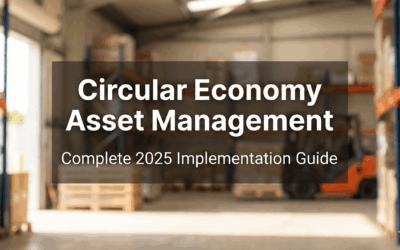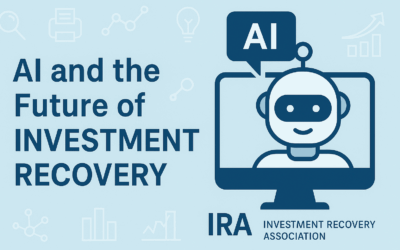
Developing Your IR Business Plan
Megan Behm, CMIR, Investment Recovery Manager at National Grid, asked the attendees at the Fall Conference, “How many have you presented a business plan?” and many raised their hands, then she asked, “How many were successful at your first attempt?” and fewer hands were raised. Megan shared her field-tested success tips and strategies on how you can ‘close’ the deal’ for getting buy-in from your leadership team.
Creating a compelling business plan for investment recovery—especially when presenting to a leadership team—requires a strategic blend of financial clarity and documentation, operational insight, employee engagement/buy-in, metrics…and the cherry on top? Persuasive storytelling.
And every IR professional has their unique and compelling story to tell that supports their organization’s bottom line and sustainability goals. You also have great insight as to how the IR function could be expanded to reach and enhance those goals. But it takes the time and attention of your executive team to get buy-in. That’s where Megan uses her background in sales to help strategically craft a presentation to leadership to close the deal.
Megan Behm is the Investment Recovery Manager for National Grid, one of the largest investor-owned energy companies in the US — serving more than 20 million people throughout New York and Massachusetts. She has been with them for six years and in the utility industry for more than eleven years. Megan shared her successful ‘from the trenches’ experience in her presentation at the fall conference, “Developing an IR Business Plan.”
Megan started off by asking the attendees how many have executed a business case within your company? There was a respectable number of raised hands. Then she asked how many were successful at their first attempt…and not so many responded. Sound familiar?
She then explained that she would be sharing some winning strategies, tips and tricks for building, presenting and executing successful business plans at National Grid.
Why storytelling is so important
You have a compelling story to tell and some great ideas to get in front of your decision-makers. Think of it as an elevator pitch, crafted to be concise and articulate, because you never know who you might run into. Like the CFO at a meeting or yes… even in the elevator. And you want to grab their attention in hopes of getting a spot on their calendar. More on presenting the bigger pitch to leadership later on.
Components of a business plan
Uncovering opportunities
It starts with pumping the brakes and taking an in-depth look at the business to identify hidden opportunities. Maybe you have groups that focus on process excellence or just talking to employees from different departments to get fresh perspectives. That’s where you can find those hidden opportunities and ask, “Hey, have you thought about a new process?” That’s where you can start thinking and acting strategically in terms of how this would support goals, mission statements, sustainability, organizational initiatives etc.
You could be walking around the warehouse or plant floor and identify a business opportunity. You spot stuff that’s been building up in the corner forever. Build a business case to move those assets for reuse, monetization, etc. That freed up space could be used more efficiently like new equipment that could streamline efficiency. And another business case for investing in new technology presents itself. One opportunity could turn into a ripple effect for others.
You want how much for that new technology?
But first are your financials, for each item in your business plan there most likely will be an initial investment, so be prepared with well-researched time and cost savings data. New equipment? “Here’s the initial cost and here’s the delta with the labor savings over X amount of months.” That’s salesmanship.
Beyond the financials
Obviously, most of the time when you’re in front of the leadership team, they are just looking at the financials. But it’s more than that. There are several varied factors that directly or indirectly impact the bottom line, and you need to articulate them and make them relevant. And that’s why you need to be super-prepared for each of them, so they will listen when time and money are involved.
That will be a recipe for success within your case.
And the risks?
This is where leadership might just pump the brakes when it comes to mitigation on financial, safety, operational and reputational risks. This is where you need to go deep and be prepared to counter/support the risk/reward that relates to your business plan. But are they going to be comfortable with that risk versus reward? One thing that Megan has learned is that you have to be uncomfortable taking risks, but without risk, there’s no reward. That’s salesmanship speak.
Process flow…have you thought it through, really?
Next is process flow—in how it will impact the organization across enterprise-wide diverse departments? What’s the structure? Let’s say you’re rolling out a sustainability program like a composting program and it touches every single aspect of the company—AKA employees. So, if you have compost containers within your office spaces, what does that look like? How does that program roll out? All of these things are key fundamental components of building your case. Because when you’re presenting your case, you don’t want to be called out on something you missed. That’s where team building comes in. Identify individuals or groups for support as you turn your vision into a green-lit reality. The more data and information that you can document from across the organization, the better your chances to be taken seriously.
Skin in the game…
Whether that be contractors or employees, if the people aren’t onboard – your business case will fail. It’s crucially important that the change management component and the voice of others is also factored in. And not just a few but the majority. They all have skin in the game. That way they’re not blindsided with change. And don’t forget, they are not only change management agents but change idea generators. For example, walking the warehouse or plant floor and asking them how to make their work and workspace more efficient. Another strategy that’s been successful for National Grid is employee surveys. When presenting to leadership the more input and buy-in from throughout the organization – the stronger your case.
Measuring success
What are your key performance indicators (KPIs)? KPIs can be both quantifiable and qualitative, and using a mix of both provides a more holistic view of performance. They must be specific, measurable, efficient and time bound. One tip that Megan shared was taking pictures, both pre- and post-implementation. Pictures are a powerful component of your storytelling…and a strategic sales tool.
Expanding your digital reach
Many IR folks need to make the business case for more digital power. Megan shared her experience with getting buy-in to augment IR’s digital reach—just when the executive team was threatening to take their domain down. Megan made a strong business case for a digital solution to manage their inventory online instead of burdensome spreadsheets and emails. This streamlined communications not only for employees but for their customers resulting in a fast-track buy-in from corporate. They were able to get the resources to make a real-time inventory catalog visible to their customers along with articulating other cost savings benefits working with National Grid. And online means anytime, anywhere access to information.
Investing in their digital presence was their way of starting to market. It’s creating another ripple effect by paving the way for more field tools to tell that story, share links and upload videos. Moreover, they were able to improve their relationship with inventory management and warehousing.
Close the deal
Your story is a strong one, but is it strategic? Does it start with a concise and relevant elevator pitch that gets you a spot on the executive calendar? Have you shared your vision and goal with employees for their buy-in? Do you have a team in place to provide documentation—both operationally and financially to counter any objections or potential risks? Can you tie in sustainability to the bottom line in multiple ways? Megan wants to see more hands raised when she next asks the question, “How many were successful in their business plan?”


